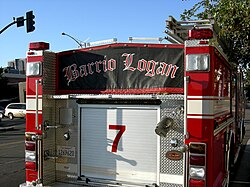Barrio Logan, San Diego
32°41′51.14″N 117°8′31.29″W / 32.6975389°N 117.1420250°W
Barrio Logan | |
|---|---|
 Banner affixed to a San Diego fire engine | |
| Country | United States |
| State | California |
| County | County of San Diego |
| City | City of San Diego |
Barrio Logan is a neighborhood in San Diego, California bordered by East Village and Logan Heights to the North, Shelltown and Southcrest to the East, San Diego Bay to the West, and National City to the South. I-5 forms the Northeastern boundary.[1]
History
In 1871, Congressman John A. Logan wrote legislation to provide federal land grants and subsidies for a transcontinental railroad ending in San Diego. A street laid in 1881 was named Logan Heights after him, and the name came to be applied to the general area.[2] Plans for a railroad never successfully materialized, and the area was predominantly residential by the turn of the century, becoming one of San Diego's oldest communities. Its transformation began in 1910 with the influx of refugees of the Mexican Revolution, who soon became the majority ethnic group. For this reason, the southern part of the original Logan Heights neighborhood came to be called Barrio Logan.[3]
The area was originally residential with access to the beach at San Diego Bay. During World War II this beach access was lost due to the expansion of Naval Station San Diego and other military facilities on the waterfront. The neighborhood continued to degrade during the 1950s and 1960s due to rezoning that permitted industrial uses, the construction of Interstate 5 through the heart of the community in 1963, and the construction of the San Diego-Coronado Bridge in 1969, which covered much of the community with a concrete "roof" supported by gray concrete pillars.[4] The city council promised to build a community park under the bridge approaches, and a site was approved in June 1969. When construction began in April 1970 at the designated site, but the community learned that the work was intended to create a state building instead of a park, there was a nonviolent community uprising. Students and others occupied the site and forced a halt to the construction. The occupation of the site lasted twelve days. Residents planted landscaping, and a local artist, Salvador Torres, proclaimed his vision of covering the freeway support pillars with murals. After intense negotiation between the city and the state (which owned the land in question), the site was reclaimed for park use, and Chicano Park was built and dedicated. It was expanded several times and in 1990 it was extended all the way to the bay, restoring beach access to the community.[5]
Chicano Park

Barrio Logan is the home of Chicano Park, a Chicano-themed public park created in large part by the local residents. It is located at the site of a 1970s demonstration, land takeover, and cultural renaissance for the Mexican-American community. It features more than 60 colorful murals painted on the concrete support piers for the San Diego-Coronado Bridge and Interstate 5. It was designated an official historic site by the San Diego Historical Site Board in 1980.
Economy
Barrio Logan is home to the Naval Station San Diego, also known as 32nd Street Naval Station, as well as the NASSCO shipyard and other military-related facilities.
Governance
Barrio Logan is part of City Council District 8 represented by Councilman David Alvarez. The Barrio Logan Community Planning Area was granted status as a redevelopment area,[6] but the state of California abolished all redevelopment areas in 2012.
Transportation
The area is served by the San Diego Trolley at the Barrio Logan station.
References
- ^ http://www.sandiego.gov/neighborhoodmaps/central.shtml
- ^ timeline of Barrio Logan history, University of San Diego
- ^ Barrio Logan community profile, city of San Diego
- ^ Delgado, Kevin, A Turning Point:The Conception and Realization of Chicano Park, Journal of San Diego History, Winter 1998
- ^ Chicano Park History website
- ^ Redevelopment Project Area webpage
